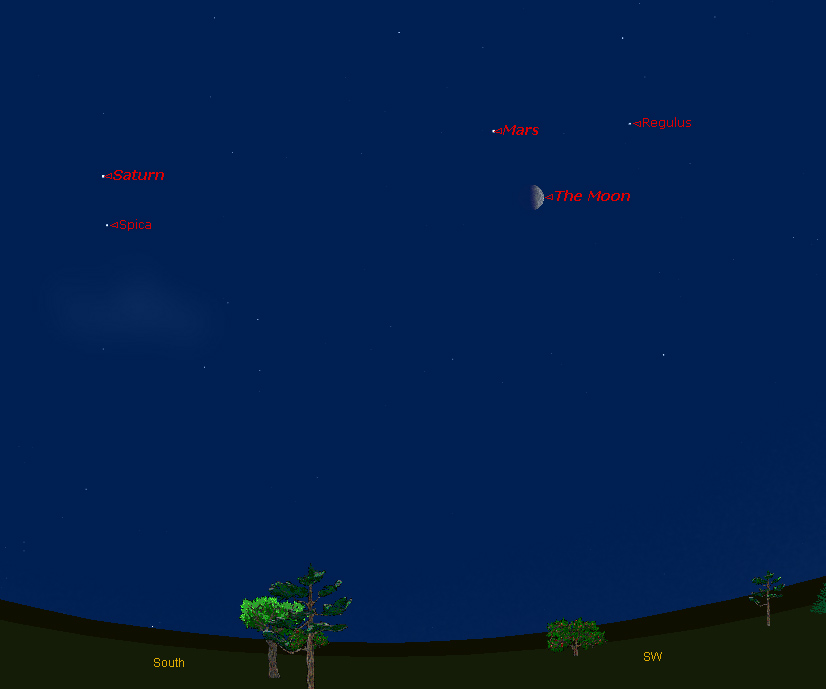
Monday evening bring us a first quarter moon, offering U.S. skywatchers a chance to close out the Memorial Day holiday with a lunar treat and the fading planet Mars.
The first quarter moon is also sometimes called the "half" moon, although as darkness falls across North America close inspection with binoculars or a small telescope may reveal that there is actually a little more than half of the moon illuminated by the sun. That's because the actual moment of first quarter occurred earlier in the afternoon at 4:16 p.m. EDT or 1:16 p.m. PDT (2016 GMT).
When it gets sufficiently dark you'll also take notice of a rather bright yellow-orange star appearing well above and a bit to the moon's left. That’s not a star, however, but a once brilliant planet that continues to ebb in brightness: Mars. Look for this colorful world shining high in the southwest during dusk and lower in the west-southwest as night grows late.
Mars will remain prominent all evening, despite the fact that it will continue to slowly fade in the days and weeks to come as it gradually pulls away from the Earth. When the moon passes it by on Monday, it will still be shining at a respectable magnitude +0.5, which is just a trifle dimmer than the ruddy star Betelgeuse in Orion. [Amazing Pictures of Mars]
Astronomers measure the brightness of objects in the sky on a magnitude scale. The lower an object's magnitude number, the brighter it appears in the night sky. Small digits and negative number magnitudes denote the brightest night sky objects.

But Mars will then be edging toward Spica and Saturn and will have a striking interaction with those two objects later in the summer.
On June 21, Mars will leave the boundaries of Leo, where it has resided since the beginning of February, and moves into Virgo. On the North American evening of June 28, Mars will pass just 15 arc minutes – 0.25 degrees – south of the 3.8-magnitude star, Beta Virginis. To get an idea of how close that is, that’s one-half the apparent width of the moon.
Get the Space.com Newsletter
Breaking space news, the latest updates on rocket launches, skywatching events and more!
Because Mars soon comes to eastern quadrature – a point in the sky that is 90 degrees east of the sun – on June 7, it should now appear distinctly gibbous in even a very small telescope. Most amateur telescopes won’t be showing any substantial detail on Mars; in fact by the end of June its apparent diameter will have shrunk to 6.6 arc seconds, which is less than half the size Mars appeared to us in early March when it was closest to earth at 62.6 million miles (100.7 million kilometers) away. In contrast, by Jun. 30, Mars will have receded to a distance of 131.8 million miles (212.1 million km) from us.
But at least we have a spacecraft heading for the Red Planet that is drawing near!
The Mars Science Laboratory, which launched in November 2011, is carrying the 1-ton Curiosity rover which is scheduled to land on the Martian surface early on Aug. 6 to begin a two-year prime mission. Curiosity's landing site is near the base of a mountain inside Gale Crater, near the Martian equator. Researchers plan to use Curiosity to study layers in the mountain that hold evidence about wet environments of early Mars.
Editor's note: If you snap an amazing picture of the moon and Mars that you'd like to be considered for use in a story or gallery, please send images and comments to SPACE.com managing editor Tariq Malik at tmalik@space.com.
Joe Rao serves as an instructor and guest lecturer at New York's Hayden Planetarium. He writes about astronomy for The New York Times and other publications, and he is also an on-camera meteorologist for News 12 Westchester, New York.
Join our Space Forums to keep talking space on the latest missions, night sky and more! And if you have a news tip, correction or comment, let us know at: community@space.com.

Joe Rao is Space.com's skywatching columnist, as well as a veteran meteorologist and eclipse chaser who also serves as an instructor and guest lecturer at New York's Hayden Planetarium. He writes about astronomy for Natural History magazine, Sky & Telescope and other publications. Joe is an 8-time Emmy-nominated meteorologist who served the Putnam Valley region of New York for over 21 years. You can find him on Twitter and YouTube tracking lunar and solar eclipses, meteor showers and more. To find out Joe's latest project, visit him on Twitter.









